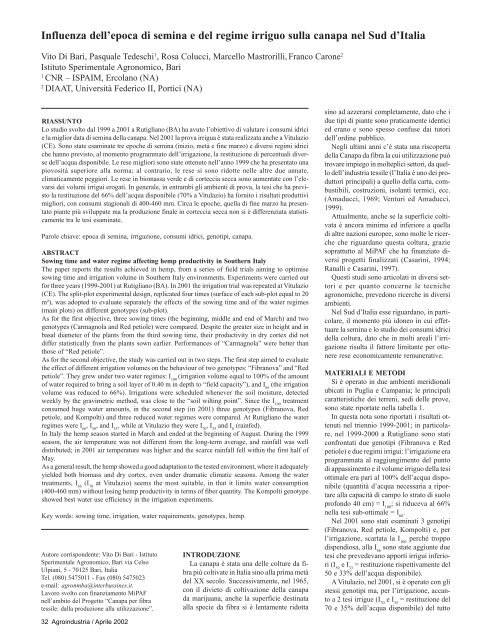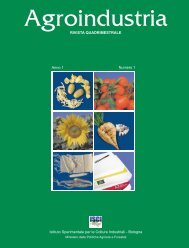Istituto Sperimentale per le Colture Industriali - Bologna ... - isci.it
Istituto Sperimentale per le Colture Industriali - Bologna ... - isci.it
Istituto Sperimentale per le Colture Industriali - Bologna ... - isci.it
You also want an ePaper? Increase the reach of your titles
YUMPU automatically turns print PDFs into web optimized ePapers that Google loves.
Influenza dell’epoca di semina e del regime irriguo sulla canapa nel Sud d’Italia<br />
V<strong>it</strong>o Di Bari, Pasqua<strong>le</strong> Tedeschi 1 , Rosa Colucci, Marcello Mastrorilli, Franco Carone 2<br />
<strong>Ist<strong>it</strong>uto</strong> <strong>S<strong>per</strong>imenta<strong>le</strong></strong> Agronomico, Bari<br />
1 CNR – ISPAIM, Ercolano (NA)<br />
2 DIAAT, Univers<strong>it</strong>à Federico II, Portici (NA)<br />
RIASSUNTO<br />
Lo studio svolto dal 1999 a 2001 a Rutigliano (BA) ha avuto l’obiettivo di valutare i consumi idrici<br />
e la miglior data di semina della canapa. Nel 2001 la prova irrigua è stata realizzata anche a V<strong>it</strong>ulazio<br />
(CE). Sono state esaminate tre epoche di semina (inizio, metà e fine marzo) e diversi regimi idrici<br />
che hanno previsto, al momento programmato dell’irrigazione, la rest<strong>it</strong>uzione di <strong>per</strong>centuali diverse<br />
dell’acqua disponibi<strong>le</strong>. Le rese migliori sono state ottenute nell’anno 1999 che ha presentato una<br />
piovos<strong>it</strong>à su<strong>per</strong>iore alla norma; al contrario, <strong>le</strong> rese si sono ridotte nel<strong>le</strong> altre due annate,<br />
climaticamente peggiori. Le rese in biomassa verde e di corteccia secca sono aumentate con l’e<strong>le</strong>varsi<br />
dei volumi irrigui erogati. In genera<strong>le</strong>, in entrambi gli ambienti di prova, la tesi che ha previsto<br />
la rest<strong>it</strong>uzione del 66% dell’acqua disponibi<strong>le</strong> (70% a V<strong>it</strong>ulazio) ha forn<strong>it</strong>o i risultati produttivi<br />
migliori, con consumi stagionali di 400-460 mm. Circa <strong>le</strong> epoche, quella di fine marzo ha presentato<br />
piante più sviluppate ma la produzione fina<strong>le</strong> in corteccia secca non si è differenziata statisticamente<br />
tra <strong>le</strong> tesi esaminate.<br />
Paro<strong>le</strong> chiave: epoca di semina, irrigazione, consumi idrici, genotipi, canapa.<br />
ABSTRACT<br />
Sowing time and water regime affecting hemp productiv<strong>it</strong>y in Southern Italy<br />
The pa<strong>per</strong> reports the results achieved in hemp, from a series of field trials aiming to optimise<br />
sowing time and irrigation volume in Southern Italy environments. Ex<strong>per</strong>iments were carried out<br />
for three years (1999-2001) at Rutigliano (BA). In 2001 the irrigation trial was repeated at V<strong>it</strong>ulazio<br />
(CE). The spl<strong>it</strong>-plot ex<strong>per</strong>imental design, replicated four times (surface of each sub-plot equal to 20<br />
m²), was adopted to evaluate separately the effects of the sowing time and of the water regimes<br />
(main plots) on different genotypes (sub-plot).<br />
As for the first objective, three sowing times (the beginning, midd<strong>le</strong> and end of March) and two<br />
genotypes (Carmagnola and Red petio<strong>le</strong>) were compared. Desp<strong>it</strong>e the greater size in height and in<br />
basal diameter of the plants from the third sowing time, their productiv<strong>it</strong>y in dry cortex did not<br />
differ statistically from the plants sown earlier. Performances of “Carmagnola” were better than<br />
those of “Red petio<strong>le</strong>”.<br />
As for the second objective, the study was carried out in two steps. The first step aimed to evaluate<br />
the effect of different irrigation volumes on the behaviour of two genotypes: “Fibranova” and “Red<br />
petio<strong>le</strong>”. They grew under two water regimes: I 100 (irrigation volume equal to 100% of the amount<br />
of water required to bring a soil layer of 0.40 m in depth to “field capac<strong>it</strong>y”), and I 66 (the irrigation<br />
volume was reduced to 66%). Irrigations were schedu<strong>le</strong>d whenever the soil moisture, detected<br />
weekly by the gravimetric method, was close to the “soil wilting point”. Since the I 100 treatment<br />
consumed huge water amounts, in the second step (in 2001) three genotypes (Fibranova, Red<br />
petio<strong>le</strong>, and Kompolti) and three reduced water regimes were compared. At Rutigliano the water<br />
regimes were I 66 , I 50 , and I 33 , whi<strong>le</strong> at V<strong>it</strong>ulazio they were I 70 , I 35 and I 0 (rainfed).<br />
In Italy the hemp season started in March and ended at the beginning of August. During the 1999<br />
season, the air tem<strong>per</strong>ature was not different from the long-term average, and rainfall was well<br />
distributed; in 2001 air tem<strong>per</strong>ature was higher and the scarce rainfall fell w<strong>it</strong>hin the first half of<br />
May.<br />
As a general result, the hemp showed a good adaptation to the tested environment, where <strong>it</strong> adequately<br />
yielded both biomass and dry cortex, even under dramatic climatic seasons. Among the water<br />
treatments, I 66 (I 70 at V<strong>it</strong>ulazio) seems the most su<strong>it</strong>ab<strong>le</strong>, in that <strong>it</strong> lim<strong>it</strong>s water consumption<br />
(400-460 mm) w<strong>it</strong>hout losing hemp productiv<strong>it</strong>y in terms of fiber quant<strong>it</strong>y. The Kompolti genotype<br />
showed best water use efficiency in the irrigation ex<strong>per</strong>iments.<br />
Key words: sowing time, irrigation, water requirements, genotypes, hemp.<br />
Autore corrispondente: V<strong>it</strong>o Di Bari - <strong>Ist<strong>it</strong>uto</strong><br />
<strong>S<strong>per</strong>imenta<strong>le</strong></strong> Agronomico, Bari via Celso<br />
Ulpiani, 5 - 70125 Bari, Italia<br />
Tel. (080) 5475011 - Fax (080) 5475023<br />
e-mail: agronmba@interbussines.<strong>it</strong>.<br />
Lavoro svolto con finanziamento MiPAF<br />
nell’amb<strong>it</strong>o del Progetto “Canapa <strong>per</strong> fibra<br />
tessi<strong>le</strong>: dalla produzione alla utilizzazione”.<br />
32 Agroindustria / Apri<strong>le</strong> 2002<br />
INTRODUZIONE<br />
La canapa è stata una del<strong>le</strong> colture da fibra<br />
più coltivate in Italia sino alla prima metà<br />
del XX secolo. Successivamente, nel 1965,<br />
con il divieto di coltivazione della canapa<br />
da marijuana, anche la su<strong>per</strong>ficie destinata<br />
alla specie da fibra si è <strong>le</strong>ntamente ridotta<br />
sino ad azzerarsi comp<strong>le</strong>tamente, dato che i<br />
due tipi di piante sono praticamente identici<br />
ed erano e sono spesso confuse dai tutori<br />
dell’ordine pubblico.<br />
Negli ultimi anni c’è stata una risco<strong>per</strong>ta<br />
della Canapa da fibra la cui utilizzazione può<br />
trovare impiego in molteplici settori, da quello<br />
dell’industria tessi<strong>le</strong> (l’Italia è uno dei produttori<br />
principali) a quello della carta, combustibili,<br />
costruzioni, isolanti termici, ecc.<br />
(Amaducci, 1969; Venturi ed Amaducci,<br />
1999).<br />
Attualmente, anche se la su<strong>per</strong>ficie coltivata<br />
è ancora minima ed inferiore a quella<br />
di altre nazioni europee, sono molte <strong>le</strong> ricerche<br />
che riguardano questa coltura, grazie<br />
soprattutto al MiPAF che ha finanziato diversi<br />
progetti finalizzati (Casarini, 1994;<br />
Ranalli e Casarini, 1997).<br />
Questi studi sono articolati in diversi settori<br />
e <strong>per</strong> quanto concerne <strong>le</strong> tecniche<br />
agronomiche, prevedono ricerche in diversi<br />
ambienti.<br />
Nel Sud d’Italia esse riguardano, in particolare,<br />
il momento più idoneo in cui effettuare<br />
la semina e lo studio dei consumi idrici<br />
della coltura, dato che in molti areali l’irrigazione<br />
risulta il fattore lim<strong>it</strong>ante <strong>per</strong> ottenere<br />
rese economicamente remunerative.<br />
MATERIALI E METODI<br />
Si è o<strong>per</strong>ato in due ambienti meridionali<br />
ubicati in Puglia e Campania; <strong>le</strong> principali<br />
caratteristiche dei terreni, sedi del<strong>le</strong> prove,<br />
sono state riportate nella tabella 1.<br />
In questa nota sono riportati i risultati ottenuti<br />
nel triennio 1999-2001; in particolare,<br />
nel 1999-2000 a Rutigliano sono stati<br />
confrontati due genotipi (Fibranova e Red<br />
petio<strong>le</strong>) e due regimi irrigui: l’irrigazione era<br />
programmata al raggiungimento del punto<br />
di appassimento e il volume irriguo della tesi<br />
ottima<strong>le</strong> era pari al 100% dell’acqua disponibi<strong>le</strong><br />
(quant<strong>it</strong>à d’acqua necessaria a riportare<br />
alla capac<strong>it</strong>à di campo lo strato di suolo<br />
profondo 40 cm) = I 100 ; si riduceva al 66%<br />
nella tesi sub-ottima<strong>le</strong> = I 66 .<br />
Nel 2001 sono stati esaminati 3 genotipi<br />
(Fibranova, Red petio<strong>le</strong>, Kompolti) e, <strong>per</strong><br />
l’irrigazione, scartata la I 100 <strong>per</strong>ché troppo<br />
dispendiosa, alla I 66 sono state aggiunte due<br />
tesi che prevedevano apporti irrigui inferiori<br />
(I 50 e I 33 = rest<strong>it</strong>uzione rispettivamente del<br />
50 e 33% dell’acqua disponibi<strong>le</strong>).<br />
A V<strong>it</strong>ulazio, nel 2001, si è o<strong>per</strong>ato con gli<br />
stessi genotipi ma, <strong>per</strong> l’irrigazione, accanto<br />
a 2 tesi irrigue (I 70 e I 35 = rest<strong>it</strong>uzione del<br />
70 e 35% dell’acqua disponibi<strong>le</strong>) del tutto



